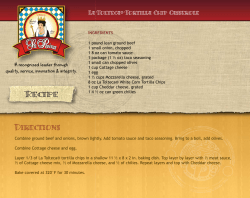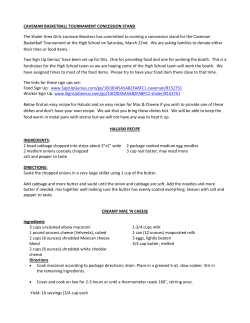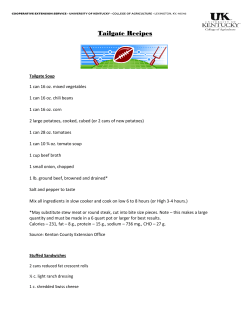
Recipe Dissection: Macaroni and Cheese
SPU 27 Week 7 Cooking Show Questions Page 1 Recipe Dissection: Macaroni and Cheese This week we will study a few recipes for Macaroni and Cheese, suggested by Erika Chan, Bianca Bamgade, Margaret Crane and Sebastian Chiu. The secret to making a good Macaroni and Cheese is to achieve the correct consistency of the sauce, the theme for the week. These different recipes achieve a good Mac and Cheese in different ways. Mouses’ Macaroni and Cheese From Allrecipes 1/4 cup butter 2 tsp (6 g) all purpose flour 1 tsp mustard powder 1 tsp ground black pepper 2 cups milk 1 cup (230 g) American cheese, cubed 1 cup (230 g) Velveeta, cubed 1/4 cup bread crumbs 1 1/2 cups macaroni 1. Melt the butter over medium heat. 2. Blend in the flour, mustard powder, and pepper until smooth. 3. Slowly stir in the milk, beating out any lumps. 4. Add the American and processed cheeses, and stir constantly until the sauce is thick and smooth. We will contrast this recipe with the simplest macaroni and cheese recipe imaginable – EasyMac, by Kraft. This method is famed for creating macaroni and cheese cheaply and quickly. This recipe was developed in 1916 when James Kraft won a patent for inventing processed cheese, which he later marketed together with macaroni in 1937. The core of the product is a mixture of emulsifying salts and powdered cheese. The directions on a box of EasyMac call for cooking 42 g of macaroni in 2⁄3 cup water, then adding 1 tsp. (5 grams) butter and 18 grams of the powdered cheese mixture. According to the label, the cheese sauce mix contains whey, maltodextrin, milk fat, milk protein concentrate, salt, and sodium tripolyphosphate, as well as minor ingredients. Our goal is to compare the viscosity between these two recipes and understand how the ingredients lead to the viscosity. For this we will calculate the volume fraction of the dry ingredients before and after cooking, and also look at each of the two resulting mixtures under the microscope. 1. A typical dry starch granule swells to double 30x its original volume during hydration.1 (a) What is the volume fraction of hydrated starch granules in the finished cheese sauce? (b) Is this volume fraction high enough to contribute significantly to the sauce’s viscosity? 2. What is the volume fraction of oil/fat in the cheese sauce? Assume that cheese is 25% fat by volume. 3. How does oil/fat contribute to the viscosity of the mixture? 4. Is this fraction large enough to contribute substantially to the viscosity of the cheese sauce? 5. Which ingredients are likely to increase the viscosity of the EasyMac cheese sauce? Explain. 6. Which of Nathan Myhrvold’s four major classes of viscosifiers occur in these recipes? 1 Recall from Week 1 that starch makes up roughly 75% of flour by weight and that ρflour = 0.59 g/mL. 1 SPU 27 Week 7 Cooking Show Questions Page 2 7. Sketch what you see when viewing each sauce under the microscope, including a scale bar. What features of each sauce are visible at this magnification? 8. How will the cheese sauce viscosity change as it cools? 9. Describe a method for testing the relative viscosities of the cheese sauces. How would you interpret your results to determine which cheese sauce is more viscous? 10. In class, we will apply one of the methods developed above to determine the effects of key ingredients on cheese sauce viscosity. Comment on whether the results met your expectations given your calculations above. 2
© Copyright 2025
















